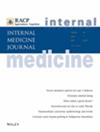Improving the timeliness of care for regional lung cancer patients through the implementation of a web-based lung cancer referral pathway
Abstract
Background
Lung cancer remains a significant public health problem and a leading cause of cancer-related mortality worldwide. The delays in the diagnosis of lung cancer are more pronounced for rural and regional Australians compared to their urban counterparts. Implementing an online HealthPathway is one way to reduce delays in the diagnosis of lung cancer.
Aim
The Townsville Lung Cancer Referral Pathway (TLCRP) was implemented to guide local general practitioners (GPs) in the referral process of people with suspected lung cancer. The aim of the study was to compare the time interval from initial GP consultation of the person with suspected lung cancer to the first specialist referral and from the first specialist referral to the initial specialist appointment, before and after implementation of TLCRP. Other lung cancer service outcomes were also compared between the pre- and post-implementation groups.
Methods
A retrospective cohort study of 316 participants was conducted, and descriptive statistical analysis of the data was used to discern any difference in timelines and other clinical outcomes in the pre-pathway implementation group compared to the post-pathway implementation group.
Results
The time interval from initial GP presentation to initial referral to specialist appointment was significantly reduced in the post-pathway group (15 days) compared to the pre-pathway group (8 days, P = 0.03). However, the time interval from GP referral to initial appointment with a specialist increased in the post-pathway group (15 and 20 days, P = 0.03).
Many of the Cancer Australia lung cancer optimal care pathway referral guidelines were not met. Only 40% of the pre-pathway group and 34% of the post-pathway group were seen in the specialist clinic within 2 weeks of GP referral. Significant proportions of patients in both groups did not have chest x-rays ordered by the GP, and the proportion of participants who were appropriately referred to the respiratory clinic did not improve after implementation of TLCRP (76% and 72%). Nearly 30% of participants in both groups were diagnosed after emergency presentation.
Conclusions
TLCRP improved the time interval from initial GP consultation to specialist referral, thus meeting its primary objective. However, better strategies are required to improve other timelines and meet Cancer Australia's lung cancer optimal care pathway guidelines.


 求助内容:
求助内容: 应助结果提醒方式:
应助结果提醒方式:


